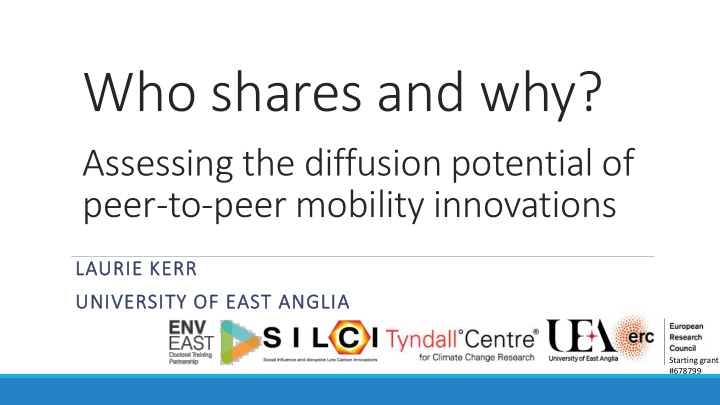



Who shares and why? Assessing the diffusion potential of peer-to-peer mobility innovations LAURIE KERR UNIVERSITY OF EAST ANGLIA Starting grant #678799
Personal mobility is undergoing a technological and social change 1998 : “Don’t get into a stranger’s car” 2008 : “Don’t meet people from the internet alone” 2018 : “Order yourself a stranger from the internet and get into their car alone”
The sharing economy • One of the ‘most significant economic developments’ of the past decade • Consumer to consumer (C2C), or peer to peer (P2P), interactions • Allow people to share, barter, lend, rent, trade, gift and swap their personal goods with others ‘ Consumers granting each other temporary access to under-utilised physical assets ’ – Frenken 2015
Peer-to-peer mobility innovations P2P car sharing P2P ride sharing An individual granting temporary access of a An individual granting temporary access of their vehicle to another individual, seat in their vehicle, and sharing a journey, often for payment with another individual, often for payment
Research question Who are the adopters of peer-to-peer mobility innovations?
Methodology Three parallel surveys: adopters of P2P car sharing, adopters of P2P ride sharing, non-adopters • Socio-economic characteristics • Personality traits Non - adopters • Communication behaviours • Travel behaviours P2P ride • Perceptions of P2P mobility P2P car sharers sharers
Methodology Three parallel surveys: adopters of P2P car sharing, adopters of P2P ride sharing, non-adopters Non - • Personality traits adopters • Trust • Sociality P2P car P2P ride sharers sharers • Technophilia P2P car sharers P2P ride sharers Non adopters Sociality ( ) Technophilia Trust
Key results - Sociality There are no significant differences between any of the three samples
Key results - Technophilia P2P car sharers are significantly* more “ technophilic ” than are P2P ride sharers P2P ride sharers are significantly* more “ technophilic ” than are non adopters *p<.05
Key results - trust P2P ride sharers are significantly* more trusting (in the platform and other users) than are non-adopters *p<.05
Key results - trust There is no significant difference between how trusting non adopters and P2P car sharers are
Identification of adopter profiles Past users Commuters Car-free Middle aged (35 – 65) Younger (under 35) “Used P2P ride sharing in Middle income Lower income the past, but not now” Use regularly Car-free households Often with the same people Use monthly or less Commuting One-off journeys
Comparisons of adopter types Commuters have significantly* higher levels of trust than do both car-free users, and past users *p<.05
Future work Aim: To assess the potential for P2P mobility innovations to reduce CO2 emissions, through an exploration of two case studies: P2P car sharing and P2P ride sharing 1. Who are the adopters of peer-to-peer mobility innovations? 2. Why do adopters use peer-to-peer mobility innovations? 3. What are the impacts of peer-to- peer mobility innovations on CO₂ emissions?
Future work – next steps Why do adopters use P2P mobility innovations? Focus groups with adopter groups (past-users, commuters, car-free households) ◦ Role of contextual factors (institutional factors) ◦ Where is the agency? ◦ Role of trust ◦ Role of sociality, relationships
Thank you for listening LAURIE KERR L.KERR@UEA.AC.UK Starting grant #678799
Recommend
More recommend